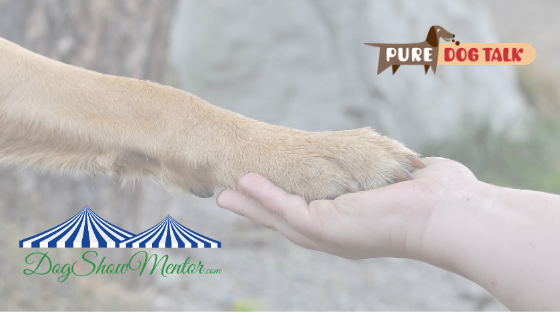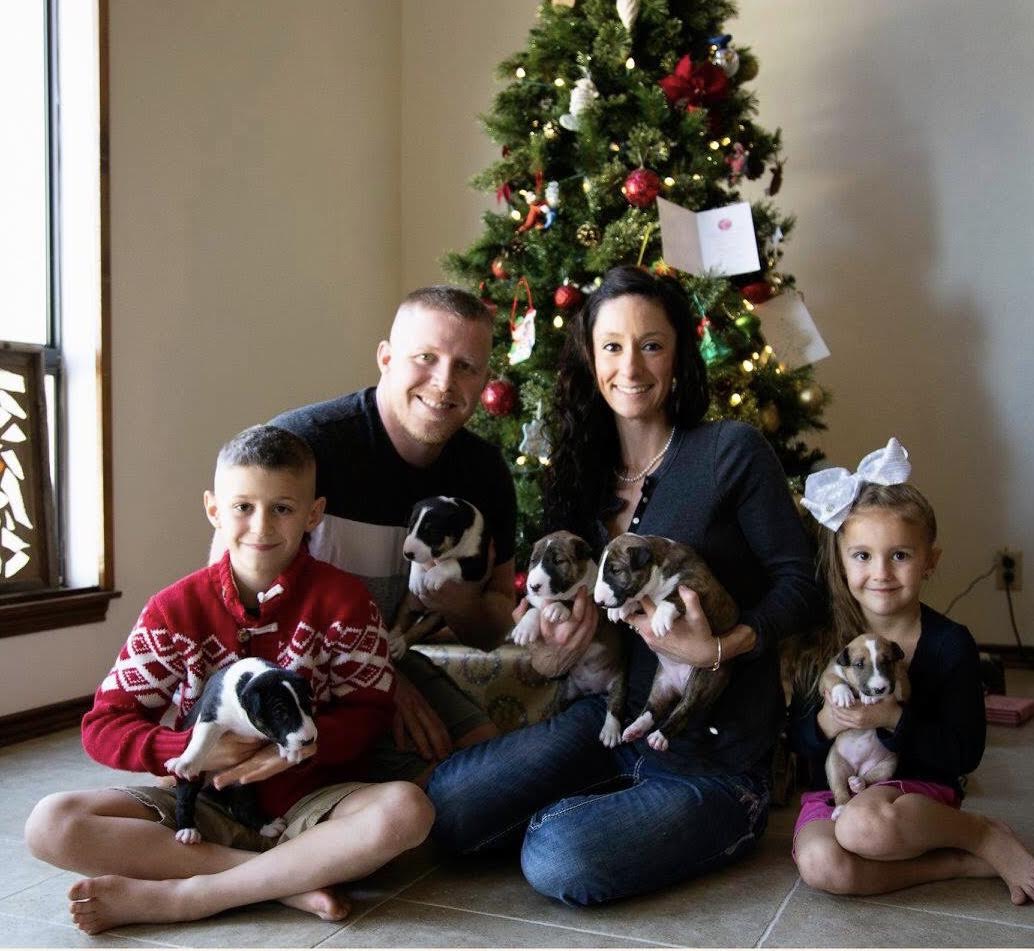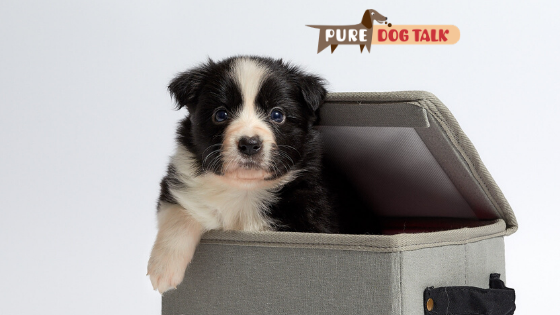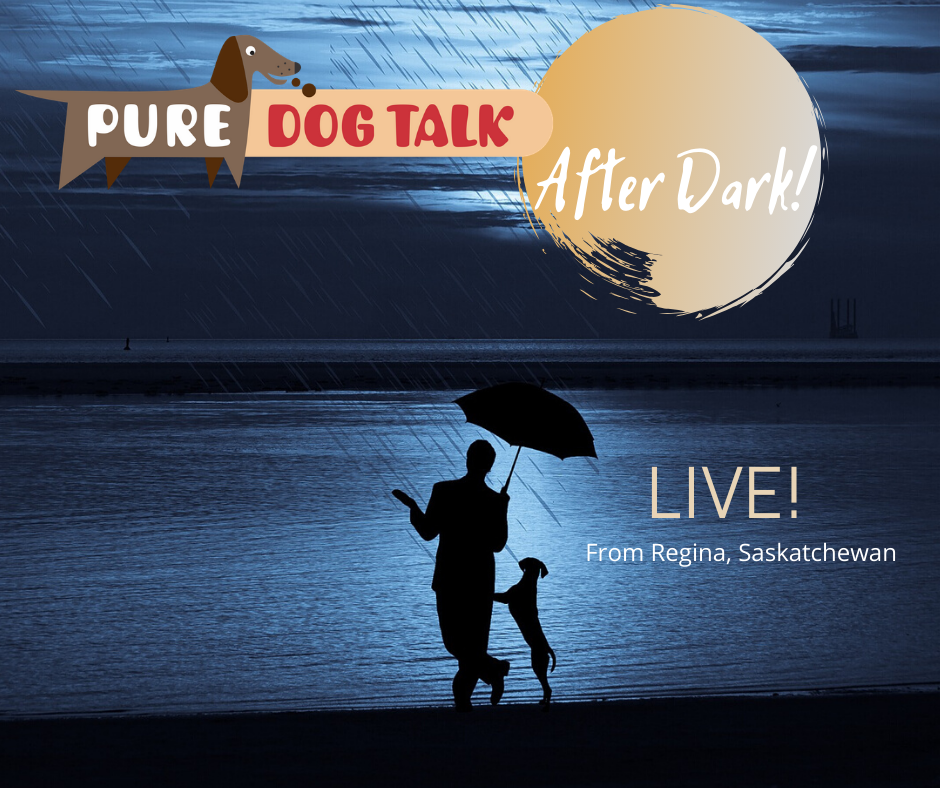Posts by Laura Reeves
379 – How To’s for Dog People to Survive Lockdown
How To’s for Dog People to Survive Lockdown
Host Laura Reeves teams up with Dog Show Mentor’s Lee Whittier to talk about the financial, emotional and dog training tools that will help our Tribe survive and even thrive in the current global crisis.
“Dog people are tough,” Reeves said. “We are, generally speaking, I think, tougher than the average bear. And we are creative and we are smart and we will be OK. I think that is so important to get to that place.
“I saw something recently that this is like a grieving process, like what place in the grieving process are you … there’s anger and there’s sorrow and there’s frustrated, that whole process. I thought that’s actually really accurate in terms of how people are approaching this.
“A lot of the people that I talk to, they’re still at anger … anger is not a useful emotion. It’s an understandable one, but it doesn’t solve anything. The sooner we can get past that and focused on, ‘yes we’re sad but what are we going to do to be proactive,’ I think is going to be very, very important for a lot of people.
“There’s a lot of pride in our community. It goes with that toughness, that independence of spirit. People are proud and they’re not gonna ask for help, even maybe if they need it.
“So if you see your handler offering a training class or a grooming clinic or anything like that, or even if it’s not someone you use as a handler, maybe it’s just someone you know in the dog show and it’s close to you and you’re able to, please, if you’re able, support those people. They’re trying to earn their money.
“There are not go fund me accounts out here for these folks. These people have pride in the work that they do … they want to be paid to do good work. Whether that work is teaching, brushing your drop coated dog, maintaining your terrier in trim, whatever it is, they want to earn the money that they’re given. They really don’t like the thought of having to ask for help.”
“For people who do handling classes,” Whittier said. “People can set up their phone and share it and for the usual $10 … get help from their handling class instructor on what to do and maybe even get more than they might get in a regular class. So if you get eight minutes from your handling instructor from a video that you took, or maybe you’re live on FaceTime, say ‘OK I’m going to pay you on PayPal and then give him an extra if used to paying $10 for your handling class, give them an extra $5.”
 Meanwhile, Pure Dog Talk is hosting a virtual dog show, Cyber Sweepstakes on our Facebook page, which closes Wednesday, 4/1 at noon.
Meanwhile, Pure Dog Talk is hosting a virtual dog show, Cyber Sweepstakes on our Facebook page, which closes Wednesday, 4/1 at noon.
“I said ‘OK, how do we help people in the community,’” Reeves said. “People are going to need help. This is just a bad space right now and people equally have a competitive urge and they have dogs in their home and they have lots of free time. So all of that ruminated in a stew in my brain and it turned into the cyber sweepstakes.
“You pay $5 on Eventbrite to enter your dog in one of 10 threads on the event on the Facebook page. It’s a one-minute video you do just like what a judge would see. The idea is pay your handler to get your dog bath trimmed videoed for one minute of headshot, teeth, profile, rear view, down and back and around. Pay your handler, pay your groomer to get your dog ready. So, this is part of money into the sport.
“Then, it’s a sweepstakes… we understand how sweepstakes works. Winners get money and more money into the community. I had thought of it as just a fundraiser and about that time Trupanion, who has been a huge supporter and sponsor of Pure Dog Talk, piped up and said ‘hey this is a really, really cool idea. We want to support it and we will match entries up to $10,000.’
“Hello! We get 1500 entries, they match that money, there’s $10,000 in a fund for our community to be developed for our people to be given to people in need. There is also $10,000 to be divvied up to the winners 1st through 4th in each of the groups plus miscellaneous. There’s money to junior showmanship. There is money to obedience … there’s lots of opportunities for lots of people. We’re not turning anybody down… If you want to support the effort and don’t have a dog to show, make an entry and your dog’s absent. The more people that participate, the more is available to go out into the community both in this fund and to the people who actually win the sweepstakes.”
Finally, it’s important to remember, Reeves noted:
“There are people who are escaping to dog shows, to work, to school… and this is a very, very scary time for those people. I think that we need to be aware, be thoughtful, be supportive, be helpful… do what we can do to support people who are in situations that are not good because this will exacerbate those. … if I’m going to be worried or scared about something, that’s the type of thing that scares me, that worries me.
“So think of your friends. Think of what you can do to help them. We need to remember people that need our help and our support. I just think that there’s a lot out there and a lot of it is hard stuff … it’s important to be positive and find positive, but it is also important, equally important, to have compassion and empathy and caring … those are really, really, really important things to bring into anything that is this terrifying.”
378 – Telemedicine for Pets Fills Need During Pandemic
Telemedicine for Pets Fills Need During Pandemic
Dr. Melissa Webster is a veterinarian at Tampa veterinary hospital and Highland pet hospital in Tampa FL. Webster shares invaluable information about telemedicine for our pets in the midst of the COVID-19 pandemic.
Shelter in place orders across the country have pet owners worried about their animals’ health and veterinarians worried about their practices. Telemedicine offers the opportunity to get help with our pets and a potential source of income for veterinarians trying to stay afloat during this crisis.
Webster works with an ap called Airvet. Pet owners pay $30 and are connected to a licensed veterinarian who can help them assess their dog’s situation.
“I can’t diagnose, treat or prescribe for your pet directly (if the dog isn’t a current patient of my brick and mortar clinic),” Webster said. “I can say ‘hey, there’s green gunk in your dog’s eye’… I can ask you historical questions, when did it occur and is she bothered by it, and we can look at it and look at her eye and decide is it something where you need to go to the vet right now, a sort of triage situation, or is it something that can be looked at tomorrow and kind of see how we can fit this into your life and help your dog.”
In some situations, like Webster’s specialty reproduction practice, telemedicine offers peace of mind for her clients that she can actually see the puppies, the dam, offer insights or suggestions without any risk of exposure for herself, her staff or her clients.
While this isn’t a solution to every situation, obviously surgery and physical intervention in a medical situation will require in person clinical visits, it is an invaluable tool in today’s upside down world.
“I think it’s a huge resource,” Webster said “and a way for us to support all the pet owners right away that’s financially a lot more attainable for the pet owners … I’m really excited to see more veterinarians coming on board that were kind of thinking ‘yeah I might do this in the future’ well here we are now … the neat things about the service that I’m a part of is that if your veterinarian isn’t available you will get a veterinarian.”
Learn more about Airvet here. Read the AVMA position statement on telemedicine here.
377 – New Dog Breeders Offer Hope for the Future
New Dog Breeders Offer Hope for the Future
Purebred dogs need more, new, young breeders. This is the consensus opinion of our top experts in the field. Preserving our breeds and encouraging more participation in our sports requires the energy and enthusiasm of youth.
So, I reached out to the Pure Dog Talk listener community to find some of these folks. This was my conversation with Sam and Curtis Brown about the breeding program they are developing in Bull Terriers (bonus, a teaser for our “rare breeds month” in April!).
This was an outstanding conversation that gave me hope for the future. Enjoy the podcast! A couple of excerpts are below.
Continue striving for better
Curtis: “I’m the one with the puppies all day and I’m the one doing multiple C-sections by myself, which I never would have seen myself doing, and delivering puppies. So, it’s difficult in that aspect. But when it comes right down to why we continue to breed, for me there are two reasons.
“The joy on the faces of the families when we get to send companion puppies home with them has always been a remarkable thing. Companion puppies that people just love forever. Our Delicious bull terrier family of everybody to who we sent puppies follows us on Facebook and continuously posts pictures of their dogs as they grow and we get to kind of see them grow.
“You’re like ‘well maybe we should have kept that one in hindsight,’ maybe next time we’ll think of it differently before we put it in a pet home. But as we go on and as we continue to breed obviously we want to continue to breed better dogs … even if we have an amazing dog or an amazing bitch like the one who we just had win the grand futurity at our Silverwood show this past year … we still want to continue to strive to breed better dogs, not only for our breed but for the betterment of our breed. … preservation breeding, continuing to do things and enhance the breed the best that we can, not just in type but the temperaments and everything.
“So that’s why I think when we continue to breed. Not just take … that one dog and then just run it until you win Westminster … or whatever the case may be. We have to continue to create the next best thing. … we go to the Silverwood specialty show and a lot of people are showing dogs that we’ve seen in the ring many, many years over and we’re the ones there with all of these young puppies …”
Family affair
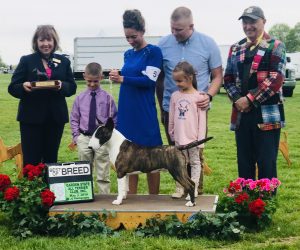
Sam: “It’s an incredible journey … you’re going to make some concessions in your personal life. Mostly sleep … but you’re also going to go all over the world you’re going to meet incredible people … we have friends that are closer than our extended family in dogs. … when you’re breeding you know you’re really doing something that’s very special. It’s not only special to you, but it’s special for those families that are going to be getting dogs from you …
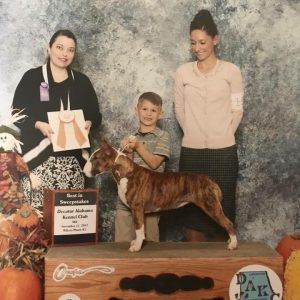 “…it’s great for kids … we do everything as a family. We go to the shows as a family. We raise the puppies as a family. We do the chores as a family. It is something that a family can do, that’s not in an agricultural area. You can raise a litter of puppies in the suburbs, it’s not a big deal … it’s something that you can sort of instill some of those 4H type lessons into your kids. We always advocate for responsible breeding … but I think it’s a positive thing and it’s definitely a family thing, at least for us, that everybody can be involved in. My kids, they’ve bottle-fed puppies and they clean up after dogs. I think that’s really important stuff when it comes to our sport. I heard Pat Trotter say at one point ‘You know it’s great to run around to get ribbons but someone’s gotta be doing the cleaning up and the breeding’ and that’s kind of where we’re at with it.”
“…it’s great for kids … we do everything as a family. We go to the shows as a family. We raise the puppies as a family. We do the chores as a family. It is something that a family can do, that’s not in an agricultural area. You can raise a litter of puppies in the suburbs, it’s not a big deal … it’s something that you can sort of instill some of those 4H type lessons into your kids. We always advocate for responsible breeding … but I think it’s a positive thing and it’s definitely a family thing, at least for us, that everybody can be involved in. My kids, they’ve bottle-fed puppies and they clean up after dogs. I think that’s really important stuff when it comes to our sport. I heard Pat Trotter say at one point ‘You know it’s great to run around to get ribbons but someone’s gotta be doing the cleaning up and the breeding’ and that’s kind of where we’re at with it.”
375 – Dog Breeding: We’re ALL in this Together
Dog Breeding: We’re ALL in this Together
Patti Strand, the founder of the National Animal Interest Alliance, joins host Laura Reeves to talk about all dog breeders working together, raising the bar for the health and well-being of all dogs.
Strand provides an outstanding historical perspective on the question of dog breeding throughout the 20th century, commercial breeding operations to meet community demand for companion dogs, the programs put in place to monitor breeders and the confusion of outdated information.
“…there is a passion among commercial breeders today to do a better job and to learn how to do a better job,” Strand said. “One of our (NAIA) board members, Marty Greer, is a veterinarian. She gives a lot of seminars, a lot of health seminars … veterinary care-type seminars in the commercial dog breeding world. And she says she never had a more attentive audience. These people are taking notes and they’re asking questions. They’re excited about breeding. They’re excited about husbandry. So just a ton of really positive changes have taken place.”
Strand, a Dalmatian breeder for decades, added, “I’m a hobby breeder. I love what I do. I try to do it well. But what I’m really working toward is trying to support people who try to conduct themselves in the best way possible with the information and education and materials that we have.”
As president of NAIA, Strand works on legislation that impacts all breeders. Including researching actual numbers of dogs in animal shelters around the US.
“I had this experience last year in working on some legislation,” Strand commented. “I had a situation where a woman who owned a pet store asked me to help her and she told me that she was doing everything right.
“(I told her) ‘if you can demonstrate to me what you’re doing and you have a solid operation I will try to help you.’ So next morning I get up and I have like 150 documents from this woman. Every single puppy she bought from somebody whose USDA inspection reports were excellent. And not only that, every single puppy she bought had parents who were health tested for the very things that the hobby dog breeder world requires when you go to our AKC parent websites. The Breeders that were working with this particular distributor were all going to the AKC and the parent club websites and finding out what the requirements were for their breed and then duplicating it. So believe me, even 5 years ago you would not have seen that,” Strand observed.
“I think the reality is that we would all want pet stores or breeders, whether they’re hobby or commercial, who are doing things badly and where animals are being harmed not to be able to operate. I mean it’s just that simple. So with us at NAIA, we’re just all about conduct rather than categorizing people by putting a particular marketing label on people and then saying this label is no good and that label is good.”
374 – To Deduct or Not to Deduct: Tax Time for Dog People
To Deduct or Not to Deduct: Tax Time for Dog People
Karen Bodeving, CPA joins host Laura Reeves for an important discussion about dogs, the IRS and your taxes. 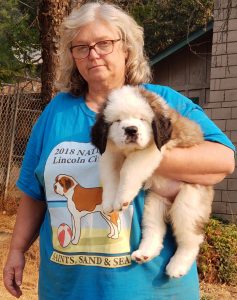 for hobby breeders, professional handlers, dog clubs and many of us involved in purebred dogs.
for hobby breeders, professional handlers, dog clubs and many of us involved in purebred dogs.
Dogs and Taxes… Who is affected
Karen Bodeving CPA, CGMA, Rogue Valley Financial
- Hobby Breeders vs Breeding as a business
- If you sell a puppy (or a litter) or take a stud fee, you still need to report it.
Hobby Breeders HAVE to show the income, but they cannot take the expenses.
If it is a Hobby: You MUST claim the Income on your tax return. – This MUST be reported in your gross income. Sell one puppy for $100 (or more)? Must be shown on your tax return!
Hobby: Can you take deductions?
The TCJA (tax cuts and jobs act) suspended miscellaneous itemized deductions until 2026, removing the ability to deduct hobby activity expenses, other than cost of goods sold.
Before 2018 -If a taxpayer’s activity is considered a hobby, he or she may deduct its expenses only up to the amount of the hobby income; therefore, a loss from a hobby cannot be deducted against other income. In addition, hobby expenses must be taken as miscellaneous itemized deductions; as such, they will be subject to the “two percent of adjusted gross income” floor, which will limit the amount of the deduction further.
This means even though you might have had $15,000 in expenses of showing etc it was not is NOT a direct offset.
After Jan 1, 2018 you can’t even take that… but you can take Cost of Goods sold – so direct expense of a litter such as stud fees, or a c-section fee would help offset the income, up to the amount of the income – (so no loss)
The good news is although you have to report the gross income, it’s not subject to Self Employment tax.
- Breeding as a Business means you TREAT it as a business. The IRS really wants to disallow your expenses under section 183 of the Internal Revenue code . But they have set some tests up to see if you are a hobby or a business.
The first test is an “OBJECTIVE” Test.
First, if a taxpayer can show that he or she realized a profit from the activity in three out of the most recent five consecutive years including the current year, the service’s objective test will be met and the activity will be considered as engaged in for profit. If the activities consist primarily of breeding, training, showing or racing horses, the presumption applies only if the activity produced a profit in 2 of the last 7 tax years, including the current year. You have a profit when the gross income from an activity is more than the deductions for it.
If your dog breeding activity passes this 3 year years-of-profit test, then it is presumed that it is carried on for profit. This means it will not come under the scrutiny and limits imposed on hobby losses. You can deduct all of your business deductions from the activity, even for the years that you have a loss. You can rely on this presumption; unless and until the IRS shows it is not valid.
The second test is the “SUBJECTIVE” test.
Do you operate your business in a business-like manner? Do you have a budget? Do you have applicable permits? Do you have a business plan? Do you have separate books and checking accounts? Can your business appreciate in value? Does it look like you gain personal pleasure from the activity (a business usually requires Work, a Hobby usually entails “Fun”).
The Tax Court has held that a couple was not entitled to deduct their net losses from a dog-breeding activity, finding that the activity was not engaged in for profit.
The most persuasive reason for concluding that the activity is a hobby is the enterprise’s bookkeeping system. The court noted that the books were posted annually, and since the couple in questions expenses could not be monitored monthly, or even quarterly, informed business decisions could not be made.
You have to seek expert advice and DOCUMENT it. There is a case of a veterinarian who lost a farm deduction (in part) because he did not do his market research and look to others for help. We, as breeders need to show not only the business acumen, but also that we looked to others for help with our dogs (e-mail group, professional handlers, vets, etc.)
Advertising is important. Are you really marketing your animals (i.e. really trying to sell them)?
PART-TIME DOG BREEDING NOT A HOBBY EVEN THOUGH IT DID NOT TURN A PROFIT.
In addition to their full time jobs, Mr. and Mrs. L bred and sold Shetland sheepdogs from 1982 to 1985. Because they limited the breeding activities to five adult dogs, the couple was not required to obtain a kennel license under state law. The Ls had no training or experience in breeding or caring for dogs, but they took the time to educate themselves. They were interested in building up a renowned kennel. They built a kennel adjacent to their house. They advertised the puppies in newspapers and magazines. They did not maintain a separate checking account for the dog-breeding activities; however, they had business cards and stationery printed up, used pre-printed invoices, kept a ledger to record expenses and kept copies of invoices for puppies they sold. The Ls provided the dogs with intensive care and were careful to place their dogs in good homes. After four years of operations, the Ls stopped selling dogs because they became convinced that they could not make a profit.
For 1984 and 1985, the Ls reported losses from their kennel activities. The Service disallowed the losses, contending that the Ls lacked a profit objective and pointing to the fact that they had reported successive losses.
Special Trial Judge Pate has held that the Ls are entitled to deduct the losses, finding that the Ls ran their kennel in a manner befitting a small business, the fact that the Ls enjoyed their business did not make it a hobby.
Inventory and Breeding Stock The IRS looks to see that you are depreciating your purchased breeding stock, as well as holding dogs in inventory for resale at the end of the year.
DOG BREEDING HELD NOT FOR PROFIT WHERE NO EVIDENCE OFFERED ON VALUE OF INVENTORY
Dr & Mrs C bred, sold and showed Pomeranian dogs. Mrs C tends to the care of the dogs generally, while the good doctor contributes about two hours per day. The doctor has been selected to judge Pomeranians at shows and has attended a course on the care and management of small animals. The Cs did not obtain a permit and kennel license as required by the county in which they live. The Cs reported aggregate losses totaling more than $30,000 in the years 1984 through 1986.
Tax Court Judge Ruwe held that the Pomeranian breeding operation was not engaged in for profit. Judge Ruwe found that although the Cs spend a considerable amount of time on the dogs, that factor was outweighed by other factors. The Court observed that the taxpayers had failed to keep businesslike records, introduced no evidence of specific plans or goals, and introduced no inventory records showing the value of each dog.
Judge Ruwe also noted the Cs accumulated expertise related only to breeding and grooming and not to the business aspects of the activity. Judge Ruwe observed that a small profit in a later year was only the result of the C’s failure to deduct several of the associated expenses that they had deducted in previous years.
After looking at these court cases, the questions becomes…are your dogs a business or a Hobby?
If it is a business – What kind of expenses is then deductible? Cost of the litter, stud fees, Kennel Fencing can be depreciated, Dog Food, Travel and 50% of your meals, in other words all ordinary and necessary expenses incurred in your business.
If the taxpayer’s activity is considered a business, the deduction of expenses and the claiming of losses are subject to the normal business expense and business loss rules. If you are engaged in the business with your spouse, unless you are in a Community Property State a partnership tax return should be filed and partnership limitations can be imposed. (and you must never, never, never, ever refer to it as a HOBBY.
- You should have a business plan on how you plan to make money.
- You should have separate checking accounts in which you put all your income from the dogs and dog expenses. Dealing in Cash is not a good thing – you need to have a paper-trail. Most real business pay with checking/debit/credit cards The cash business are being watched closely by the banks and being reported.
- You need to be doing 1099’s to your veterinarian regardless if they are incorporated or not – if you payed by check or with cash.
- Per IRS Letter ruling Per Letter Ruling 201349013 They fall under the Health and medical services –
- but non business i.e. hobby owners do not need to do this.
- You also need to 1099 your handlers, groomers and anyone else you pay more than $600 to in a year. – INTENTIONAL Disregard is $550 per instance with no limitation.
- You need to have current proper permits through your city/county/state. That may mean you may need to have Kennel inspections including by the USDA.
- You will need to track your mileage – Use an app like Mile IQ –or keep a mileage log in your van. Keep your ribbons – I went through a dog /business audit where we had ribbons to prove where we were …and could google map the distances to prove mileage. Mileage includes going to the vet, going to the bank – anything that is Business related.
- Meals – There are new rules regarding meals and entertainment – make sure you log any business purposes – if you are with a potential puppy buyer or if you are out at a show.
- You will need to keep a copy (or photo) of all your receipts. Dog food, postage, etc….
- The years that you do make a profit, if your business is not incorporated, you will be subject to tax and self employment tax.
- Ignoring ANY puppy income WILL get you in trouble, so please consult with a professional and report it correctly – the money you spend on doing it right it will save you in the long run.
- Handlers (and Judges)
- I’m going to through these in together because of the travel.
- IF someone else (your client or club) pays for your travel, or directly reimburses you after you pay for it and you turn in your receipts, then they do not need to have that on your 1099. BUT remember, if they are a hobby, they can’t deduct it and as a Handler is a business, you can. Be nice to your clients.
- Business meals with clients or on a business trip is still 50% deductible,
- I’m going to through these in together because of the travel.
- Meals with your friends or taking your spouse is nondeductible.
- Obviously, mileage is a huge deduction – make sure you document it using either an app or a log.
- Keep your receipts. It’s tough in a van full of dogs to hang on to all your receipts – use an app such as receiptbank or quickbooks where you can snap a photo of the receipt an upload it to your books.
- If a handler is working for just one client long term, you are an employee – make sure you are getting payroll taxes withheld.
- And speaking of employees, make sure you put your helpers on payroll or 1099 them if they qualify. Remember if one of your helpers gets bit, they may file a workers comp claim, so you need to have it in place.
- Keep track of who owes you money – and don’t let it lag to far. It’s tough working a large show, but get your bills out immediately and stay on your collections before the next show comes up. If you can use Xero or Quickbooks online, you can bill from your cell phone and use an app like T-sheets to keep your time going so you aren’t missing any billings.
- And HANDLERS – Set up a retirement plan and exit strategy – start small, but put something back as your body will break down and you need to have a way out.
- Clubs
- Make sure your treasurer gives the board a bank reconciliation each month and copy of the bank statement and that a non-signing board member has reviewed.
- Make sure you have a way to close the account if the treasurer leaves. That may be by having a signature card already signed off.
- Know what kind of club you are – If you are a 501 c 7 (club) you can’t let folks deduct donations.
- Get those 1099’s out to your judges and any other folks you hire. Remember the veterinarian rule we spoke about – If you hold an eye or other health clinic you may be missing this.
- Make sure that if you are putting on dog shows you are reporting them correctly for the type of non-profit you are- There was a tax court case lately where a dog show was deemed a profit making venture and not with the objectives of the club. Seek professional help to make sure the reporting is done and done correctly.
We do tax returns for people all over the US – our information is dogsandtaxes.com and we offer a ½ hr get to know you appointment either in person, over the phone or via teleconference.
****
Karen Bodeving, CPA, CGMA (Certified Public Accountant and Charter Global Management Accountant). The business, Rogue Valley Financial Services, which provides Tax, Bookkeeping, and other Financial services for clients throughout the country.
Karen has been involved in purebred dogs since 1996 – at which time she and her Husband Paul and their two young daughters established Shadow Mtn Saint Bernards. Karen and her husband Paul are both AKC judges and All-breed Jr. Judges. (Karen has judged the National as well as two World Union of Saint Bernard). She has served on many Club boards, including 2 time President of the local all breed club and Two time President of the Saint Bernard Club of America, and Paul is an AKC delegate.
After aging out in Jrs and leaving the nest, both the daughters continued into purebred dogs into adult hood, the youngest having worked for a handler, the oldest changed breeds (hunting/showing Coonhounds), but continues on with Saints also. They also both continued into the accounting field, and the oldest (Dani) has joined Karen at Rogue Valley Financial.
The family background in all aspects of purebred dogs gives Karen and Dani a unique perspective for tax and financial purposes. Rogue Valley Financial does a variety of services for the dog fancy, as outlined in this blog.
373 – Protecting Ourselves and Our Dogs from Legal Jeopardy
Protecting Ourselves and Our Dogs from Legal Jeopardy
In light of an increasing number of aggressive and questionable prosecutions of purebred dog hobbyists in local jurisdictions, Dale Martenson and host Laura Reeves discuss prevention and preparedness.
We maybe own the dogs, but the responsibility owns us back – Dale Martenson
“We are our brothers keepers in this,” Martenson said, “because every time we hear one of the salacious stories about somebody who is famous or a very successful longtime person ending up in trouble, that is when we as a community as a whole have failed because we need to be there in a little bit of a way, lifting each other up and kind of helping, maybe sometimes even saying something a little bit truthful…
Constructive Criticism is Good
“Embracing the inspections and licensing with open eyes and receiving criticism, constructive and otherwise, is a big plus when you are putting together your facility to keep the dogs. You really need to have a facility that fits your breed and your climate. Like my little 24 inch X pens for Japanese Chin probably would not work so well with your German wirehaired pointers…
“You really need to know what you need to keep your dogs, how you need to maintain them, how you need to keep them healthy and happy. Then also take that extra step. I enjoy signs and plants and stuff, so my kennel (has) a garden … I spend a lot of time in there.
An Ounce of Prevention
“If you’re hiring help that you’re not aware of, that you don’t know, this is not someone that you know intimately … then perhaps you should take an extra moment and do a little bit of background check on them… some places actually have non-disclosure agreements and “accepting of liability statements” so if someone takes a picture of a dog that they’re supposed to be caring for in your facility and then shares this in some sort of inhumane way that they are legally responsible for that as an employee.”
“I guess that the whole thing is to try not to break the rules … Just because we have ribbons from the dog show, does not exempt us from the rules. The rules are the rules and they don’t care that your dog won the group in the Garden. If you have 35 dogs and you’re only allowed to have five where you live (for example) you’re putting your dogs at jeopardy.”
372 – Bugs are Coming! Safe Products for Breeding Dogs + Coronavirus
Bugs are Coming! Safe Products for Breeding Dogs + Coronavirus
Dr. Marty Greer brings her pragmatic Veterinary Voice to the topic of Coronavirus and what products are safe to use for flea, tick and heartworm prevention in breeding dogs.
COVID-19 is not currently believed to be communicable between humans and dogs. Coronavirus is a general term for a *shape* of a virus and encompasses a variety of viral infections in many species. For more information on recommendations regarding veterinary care during this outbreak, click here.
As spring brings the reemergence of various creepy, crawly parasites that affect our dogs, Greer provides in-depth information about which products are safe for use on dogs in our breeding programs, including brood bitches and stud dogs over the course of time, as well as bitches in whelp.
Greer said, “I think it’s really appropriate for us to stick to the EPA and FDA approved drugs that we know have been tested and safe in breeding animals. So, for instance, Bravecto says there were no clinically relevant treatment-related effects on body weights, food consumption, reproductive performance, semen analysis, litter data, gross necropsy or Histology findings in adults and puppies. So we need to be looking for that kind of language on a label before we go slapping things on or popping things into our dogs … I just want to be perfectly clear for what products have or have not been tested.
“So there’s three basic categories of flea and tick medications. There’s the collar, there’s the topical, the oil that goes over the back of the neck or down the back and there’s the tablets or the chewables. So there are the three general categories and of those three there’s no collar …. labeled for that use in breeding dogs … the topicals, some are definitely labeled and some are not definitely labeled. …if it says like Frontline says safe for breeding, pregnant and lactating dogs and cats, then it’s safe. If it doesn’t say that you shouldn’t use it. It needs to be clear. And if we look at the oral there’s …. three oral medications that are not labeled for use in breeding animals. Bravecto is labeled for use in breeding animals. So we need to be really, really clear that we’re looking at the labels or reading the instructions and we’re thinking at eight weeks of age, what is the this dog’s future, not just is she pregnant right now, but what is her future.”
| Product | Active Ingredients | Purpose/Effective Against | Minimum Age/Weight | Pregnant/Nursing/Male | ||||
| Heartworm | ||||||||
| Advantage Multi for Dogs | Imidacloprid and moidectin | Flea, louse, heartworm, hookworm, whipworm, roundworm and mange. Topical every 30 days | 7 weeks/3lbs | Safety not established. | ||||
| Advantage Multi for Cats | Imidacloprid and moxidectin | Ear mites, flea, heartworm, hookworm and roundworm. Topical every 30 days | 9 weeks/2 lbs | Safety not established. | ||||
| Heartgard Plus | Ivermectin,
Pyrantel pamoate |
Heartworm, roundworms & hookworms Tablet every 30 days | 6 weeks | Safe in pregnant or breeding bitches, stud dogs | ||||
| Heartgard | Ivermectin | Dog: Heartworm. Tablet every 30 days
Cat: Heartworm and hookworm. Tablet every 30 days |
6 weeks | Safe | ||||
| Interceptor | Milbemycin oxime | Heartworm, hookworm, whipworm, roundworm. Every 30 days | Dog: 4 weeks/2 lbs
Cat: 6 weeks/1.5lbs |
Dogs: Safe
Cat: Not established |
||||
| Interceptor Plus | Milbemycin oxime and praziquantel tablet | Heartworm, roundworm (Toxocara canis, Toxascaris leonina), adult hookworm (Ancylostoma caninum), adult whipworm (Trichuris vulpis), and adult tapeworm (Taenia pisiformis, Echinococcus multilocularis and Echinococcus granulosus) Tablet every 30 days | Dogs and puppies 2 pounds of body weight or greater and 6 weeks of age and older. | Safe
Not evaluated in breeding, pregnant or lactating dogs. Only milbemycin has been studied and is safe. |
||||
| Iverhart Max | Ivermectin,
Pyrantel pamoate, praziquantel |
Heartworm, roundworms, hookworms, and tapeworms. Tablet every 30 days | 8 weeks/6 lbs | Safe in pregnant or breeding bitches, stud dogs
Not evaluated in pregnant or lactating. Safe in males. |
||||
| Iverhart Plus | Ivermectin,
Pyrantel pamoate |
Heartworm, roundworms, and hookworms, every 30 days | 6 weeks | Safe in pregnant or breeding bitches, stud dogs | ||||
| Revolution | Selamectin | Dog:Heartworm, Fleas, flea eggs, scabies,
ear mites, hookworms, roundworms, lice (Trichodectes canis), ticks (Haemaphysalis leachi &Rhipicephalus sanguineus), Topical every 30 days.
Cat: Heartworm, roundworm, hookworm, fleas and mites. Topical every 30 days. |
Dog: 6 weeks
Cat: 8 weeks |
To prevent roundworm infection, REVOLUTION
should be administered at monthly intervals during pregnancy with a dose administered approximately 2 weeks before parturition. The next treatment should be administered to the bitch or queen, ten days after parturition and followed by another treatment 1 month later. This schedule of treatments for bitches and queens will prevent adult roundworm infections in suckling puppies and kittens for 7 weeks after birth. |
||||
| Sentinel | Milbemycin, Lufenuron | Heartworm, roundworms, whipworms, hookworms & flea eggs. Tablet every 30 days | 4 weeks & 2 lbs | Safe | ||||
| Sentinel Spectrum | Milbemycin, Lufenuron, Praziquantel | Heartworm, roundworms, whipworms, hookworms & flea eggs, tapeworms.
Tablet every 30 days |
6 weeks & 2 lbs | Not tested | ||||
| Tri-Heart Plus | Ivermectin,
Pyrantel pamoate |
Heartworm, roundworms and hookworms every 30 days | 6 weeks | Safe | ||||
| Trifexis | Milbemycin oxime and Spinosad | Heartworm, fleas, roundworms, hookworms, & whipworms. Tablet every 30 days | 8 weeks & 5 lbs |
Not safe in pregnancy due to fetal malformations, not evaluated in males. Caution in dogs with seizure history. Use with caution in breeding females. | ||||
| Flea and Tick | ||||||||
| Advantage II | Imidacloprid & insect growth regulator (pyriproxyfen) | Adult fleas, flea larvae, flea eggs, lice.
Every 30 days |
3 pounds & 7 weeks | Consult your veterinarian before using this product on debilitated, aged, pregnant or nursing dogs. | ||||
| BioGroom | Pyrethrin shampoo | Kills fleas, ticks, lice, and ear mites. | 5 pounds & 12 weeks | Consult a veterinarian before using on sick, aged pregnant or nursing animals. | ||||
| BioSpot Active Care Spot on |
|
Fleas, Flea Eggs, Flea Larvae, Tick, Tick Nymphs, Tick Larvae, Brown Dog Ticks, Deer Ticks
Kills & Repels: Mosquitoes Every 30 days. |
12 weeks. | No | ||||
| Bravecto | Fluralaner | Dog: Fleas, ticks 12 weeks (Ixodes scapularis – black-legged tick, Dermacentor variabilis – American dog tick,and Rhipicephalus sanguineus – brown dog tick), and for 8 weeks (Amblyomma americanum – lone star tick). Topical
Cat: Flea, ticks 12 weeks (Ixodes scapularis – black-legged tick. Dermacentor variabilis (American dog tick) infestations for 8 weeks. Topical
|
Dog:6 months/4.4 lbs
Cat: 6 months/2.6 lbs |
Dog: There were no clinically-relevant, treatment-related effects on the body weights, food consumption, reproductive performance, semen analysis, litter data, gross necropsy (adult dogs) or histopathology findings (adult dogs and puppies). Bravecto has not been shown to be effective for 12-weeks duration in puppies less than 6 months of age.
Cat: Not established. |
||||
| Capstar tabs | Nitenpyram | Dog and Cat: Fleas as often as 1 x a day | 4 weeks/2 lbs | Birth defects & fetal loss | ||||
| Certifect | Fipronil, Amitraz
S-methoprene |
Deer ticks, Gulf Coast ticks, Black legged ticks, Brown Dog ticks, American Dog ticks, Lone Star ticks, Yellow Dog ticks, European Dog ticks, Wood ticks, and Paralysis ticks | 5 pounds & 8 weeks | Can also be used on breeding pregnant and lactating bitches. | ||||
| Comfortis | Spinosad | Dog: Fleas. Tablet every 30 days | 3.3 pounds & 14 weeks | The safe use of COMFORTIS in breeding, pregnant, or lactating cats has not been evaluated. Caution in dogs with seizure history.
Safety has not been evaluated in breeding males. Use with caution in breeding females. |
||||
| Credelio | Lotilaner | Dog: Adult fleas (Ctenocephalides felis) and ticks [Amblyomma americanum (lone star tick), Dermacentor variabilis (American dog tick), Ixodes scapularis (black-legged tick) & Rhipicephalus sanguineus (brown dog tick). Tablet every 30 days. | 8 weeks of age & 4.4 pounds | The safe use of CREDELIO in breeding, pregnant or lactating dogs has not been evaluated. Use with caution in dogs with a history of seizures. | ||||
| FiproGuard | Fipronil & s-methoprene | Fleas & ticks. Every 30 days | 8 weeks | Safe for breeding, pregnant, and lactating dogs | ||||
| FiproGuard Plus | Fipronil, (s)-methoprene, and novaluron | Dog and Cat: Fleas, ticks, and lice.
Topical every 30 days. |
Dog: 8 weeks
Cat: 8 weeks/1.5lbs |
Safe for breeding, pregnant, and lactating dog and cat. | ||||
| Frontline | Fipronil | Fleas, ticks and chewing lice. Waterproof. Every 30 days. | 8 weeks | Can be used on breeding, pregnant & lactating bitches | ||||
| Frontline Plus | Fipronil and (S)-methoprene | Dog: Fleas including eggs & larvae, ticks, mites/mange, and lice. Topical every 30 days.
Cat:Fleas including eggs & larvae, ticks and lice. Waterproof. Topical every 30 days. |
Dog: 8 weeks/5 lbs
Cat: 8 weeks/1.5lbs |
Safe for breeding, pregnant, and lactating dog and cats. | ||||
| Frontline Spray | Fipronil | Fleas, Ticks and Chewing Lice. – Kills all life stages of ticks (larva, nymph and adult), including brown dog ticks (Rhipicephalus sanguineus), American dog ticks (Dermacentor variabilis), lone star ticks (Amblyomma americanum) and deer ticks (Ixodes scapularis).Wear gloves. Approximately 1 to 2 pumps per pound of the animal’s body weight will be required. Pets with long or dense coats will require the higher rate. Waterproof. 30 to 90 days. | 8 weeks | Approved for use on all dogs, including breeding, pregnant, and lactating bitches and puppies as young as 8 weeks.
|
||||
| Frontline Gold | Fipronil, (s)-methoprene, pyriproxyfen | Cats and dogs: Flea, tick and chewing lice. | Dog: 8 weeks/5lbs
Cat: 8 weeks/1.5lbs |
Safe | ||||
| Hartz First Defense | Fipronil | Fleas, ticks and chewing lice. Waterproof. Every 30 days. | 8 weeks | BREEDING, PREGNANT AND LACTATING BITCHES, | ||||
| K9 Advantix II | Imidacloprid, Permethrin*, & Pyriproxyfen | Ticks, fleas, mosquitoes, biting flies and lice. Every 30 days, can reapply in 7 days. | 7 weeks/4lbs | NO CATS. Consult your veterinarian before using this product on debilitated, aged, pregnant or nursing animals. | ||||
| Nexgard | Afoxolaner | Fleas & ticks. Every 30 days. | 8 weeks & 4 lbs | Not tested. Caution in dogs with seizure history. | ||||
| PetArmor | Fipronil | Fleas & ticks. Every 30 days. | 8 weeks | Safe for breeding, pregnant, and lactating dogs | ||||
| PetArmor Plus for Dogs | Fipronil and
S-Methoprene |
Adult fleas, flea eggs, flea larvae, ticks, chewing lice and prevents the development of flea pupae. It controls mites that may cause sarcoptic mange and kills deer ticks that can transmit Lyme disease. It also kills brown dog ticks, American dog ticks, and lone star ticks and prevents flea reinfestations for 4 weeks. | 8 weeks. | Safe for breeding, pregnant, and lactating dogs | ||||
| Preventic Collar | Amitraz | Ticks for 90 days | 12 weeks | Not tested. No cats. | ||||
| Revolution | Selamectin | Heartworm, fleas & flea eggs, ear mites, Sarcoptes, American Dog Tick. Every 30 days | Dog: 6 weeks
Cat: 8 weeks |
Safe | ||||
| Scalibor Protector Band | Deltamethrin | Fleas & ticks. Every 6 months. | 12 weeks | Consult a veterinarian before using this product on debilitated, aged, pregnant, medicated, or nursing animals. | ||||
| Sentry Capguard | Nitenpyram | Fleas. | 2 pounds & 4 weeks | Birth defects & fetal loss | ||||
| Sentry Natural Defense | Dog: Peppermint oil, cinnamon oil, lemongrass oil, clove oil & thyme oil
Cat: Peppermint oil, clove oil, & lemongrass oil. |
Fleas, ticks and mosquitoes. Every 30 days | 12 weeks | Attacks octopamine. Consult vet. | ||||
| Seresto collar | Flumethrin & Imidacloprid | Fleas, ticks, lice, sarcoptic mites. 8 months | 7 weeks and 18 pounds | Consult your veterinarian before using this product on debilitated, aged, breeding, pregnant, or nursing animals. | ||||
| Simparica | Sarolaner | Adult fleas, and is indicated for the treatment and prevention of flea infestations (Ctenocephalides felis), and the treatment and control of tick infestations [Amblyomma americanum (Lone Star tick), Amblyomma maculatum (Gulf Coast tick), Dermacentor variabilis (American dog tick), and
Rhipicephalus sanguineus (brown dog tick)]. Every 30 days. |
6 months & 2.8 pounds | Not tested | ||||
| Spectra Shield | Zetacypermethrin & Piperonyl Butoxide | Fleas & ticks. Lasts up to 4 months. | 6 months | If used on pregnant or nursing dogs, do not replace medallion until puppies are at least 6 weeks old. | ||||
| Vectra 3D | Dinotefuran, Pyriproxyfen, & Permethrin | Fleas & ticks. Every 30 days. Mosquito & biting flies, sand mites, lice repellency. Water repellency. “Hot foot” effect before they bite. | 8 weeks & 2.5 pounds | Label says “do not use” | ||||
| Vet’s Best Natural Flea & Tick spot-on | Clove Leaf Oil, Thyme White Oil, Cinnamon Oil | Fleas and ticks, repels mosquitos. | 12 weeks | Label is silent. |
371 – Pugs: Mischievous and Charming Companions CAN Work
Pugs: Mischievous and Charming Companions CAN Work
Three long-time breeders join host Laura Reeves to talk about all things Pugs. Kim Langlands, Brenda Belmonte and Patti Kolesar Stoltz share the joy of Pug dogs, their companionship, their functionality, their snoring and their health.
Ancient history
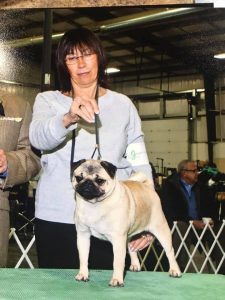
Patti Kolesar Stoltz
“The exact origin of our breed is actually lost in antiquity,” Kolesar Stoltz said. “What we do know is that the Pug is of Chinese origin … he was known in the Orient as early as 700 BC … the breed was developed as one of three short faced dogs bred in China for the Imperial court … it’s believed that the Pug found his way to the western world via Dutch merchant traders … because when people from the Western world, at that time, would go to China and conquer, they would bring back presents for their Royals. Pugs were one of the presents that they brought back and they became the favored of monarchs throughout Europe. There is no doubt that the Royal patronage helped to establish the popularity of the breed. In fact, Pug dogs were twice the most popular breed in Europe, in the late 1600s and during the Victorian era… the wonderful thing about Pugs being so popular in the Victorian era is we can visually follow our breed through history because it was very often the favorite subject depicted in many forms of art — early paintings, sculptures, porcelains, so we can follow his history … the breed has a wonderful temperament. They make ideal companions. We were admitted to the American Kennel Club in 1885. We are the largest of the toy breeds and we are one of the most mischievous, also the most fun. And we still remain dignified loving and trusting of everybody.”
Myth busting
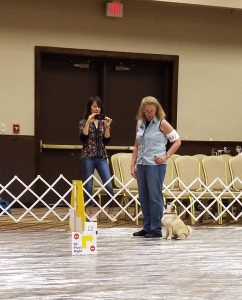
Brenda Belmonte
It’s a pervasive myth that these flat nose breeds can’t breathe normally, Belmonte noted, therefore they can’t do normal things.
“It’s unfair to our breed to just assume that because it’s a Pug it’s unhealthy,” Belmonte added, noting her work with the breed in nosework, agility and obedience. “I think the general public needs to hear that and they need to see what our pugs can do so that we can combat this belief that, ‘Oh my gosh our pugs are unhealthy,’ that’s very, very far from the fact. As a
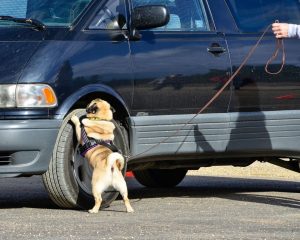
Belmonte’s pug competing in nosework.
breeder and somebody who’s been in the breed a long time, I truly believe that good breeders have the best interest of their dog’s health at heart. So yes, it’s about being a good, responsible breeder and it’s about knowing that these dogs can breathe normally and they can do the things other dogs can do.”
Healthy habits
Langlands observed that, although the breed has evolved as time has gone on, the brachycephalic dogs were never intended to run marathons.
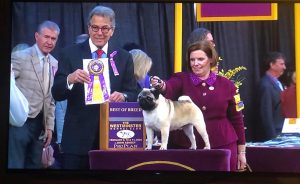
Kim Langlands
“This is a breed (that is) more than capable of doing agility and other performance events and going out and being good little happy pets and going for walks,” Langlands said. “They’re as healthy as people want them to be and take care of them to be. If you take good care of your dog, you’re going to have a happy healthy pet … and that includes taking care of their teeth, their nose roll, their weight. I mean the weight is a huge issue.”
Color questions
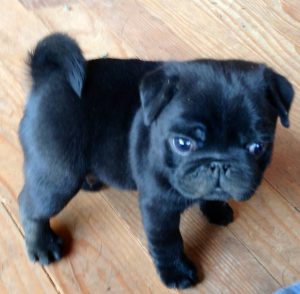
Pugs are black or fawn.
Kolesar Stoltz, who heads up education for the Pug Dog Club of America, reminds our audience that pugs come in fawn or black. Period.
“Fawn has various shades of real light blonde to what we call an apricot fawn, which has got a very, very pale, pale orange tinge to it… the fawn dogs also have black guard hairs … the fawn dogs all have black masks and black hairs and usually black in their head wrinkle. The black dogs are black … black can be various shades of black depending on if your dog’s been out in the sun and his coat is sunburned, so he might get a little reddish tinge to it or undercoat … grey undercoat …. but pugs are not albino. They’re not spotted. They’re not black and tan. They’re not brindle and they’re not blue. Pugs come black or fawn. Any other color is a disqualification in our breed and somewhere back in their pedigree is something that shouldn’t be there.”
370 – How Judges Decide Placements: Conformation and Obedience
How Judges Decide Placements: Conformation and Obedience
Part two of our panel discussion at the Regina Kennel and Obedience Club’s Prairie Christmas Dog Show with an international coterie of judges focuses on: the details of breed type and presentation, exercising patience, judging uncropped and undocked dogs, legislation and growing our sport.
From Sue-Ellyn Rempel on making a final placement:
“I guess for me general outline for starters and then movement is very breed specific for me. So I kind of go by that…. they have to scream German Shepherd … a lot of times we get … a class of 5 and they’re all generic … they get from point A to point B really well they stack and their moderately angulated like the breed should be but they’re not smooth, they don’t flow in the correct way…. like the make and shape difference in the shape from a Great Dane to a whippet… whippets you want the beautiful soft gentle curves… that’s gotta hit me right away… when I look at them, that they are the right shape and then when they take the steps, that puts the picture together for me.”
From Frances Smith on what she sees in the ring:
“I find it very important to reward the breed specific, unique characteristics because (there are) a lot of generic dogs, too many generic dogs, too many dogs that finished championships that really… shouldn’t be … because supposedly a champion is a superior specimen of the breed. So it’s up to us to keep the quality and to reward those breed specific points because without them we lose those identifying points of each breed. I want to add another thing that’s very important, temperament, which is also one of the 6 points in type, … because the temperament has to belong to the breed …without the correct temperament I don’t care if a dog is extremely showy, he’s gotta have the breed’s temperament. I don’t want just a fancy dancer in the ring … I don’t want to see a dog jumping and doing things that aren’t typical of his breed.”
From Diana McKenzie on changes she’s seen in her time in the sport:
“There’s been a ton of changes over the years in obedience … even training methods OK these days are so different from what they were 20-30 years ago. … unfortunately a lot of people go into obedience and they think it’s easy. OK rally is easy, yes. Obedience is not easy. It is not a given and it’s something that you as a handler have to work with your dog to attain a nice working relationship with and train the behaviors. Rally is easy to me, I shouldn’t say it’s easy to everyone, but it’s a wonderful venue to train with your dog and teach your dog in a positive way how to move its rear end and be aware of its rear end movement which a lot of people don’t do. (That’s) just one small thing that you can think of to work with them. Fronts, finishes, drops, all of that are in rally obedience as well as the heeling, so when you see a team in rally obedience and they are true team it’s wonderful. … in obedience … over the years training methods are changing. Corrections, harsh corrections, are becoming less and less used (people are) more into the purely positive methods. That’s wonderful, if you know how to do it properly. A lot of people don’t, therefore they get a brat in a dog that goes in (and says) “I don’t have to ’cause there are no consequences…”
369 – Judges Share View from the Center of the Ring
Judges Share View from the Center of the Ring

The Prairie Christmas Dog Show judging panel on “pajama day”…
These judges share their 411 stories and their views from the center of the ring. This is part one of two from our panel discussion at the Prairie Christmas Dog Show in Regina, Saskatchewan.
Our panelists share common paths to involvement with purebred dogs. Frances Smith talks about family connections and, bonus, the story of transporting Yorkshire Terriers from England to Argentina by ship. Obedience competition that started with a mixed breed dog brought obedience judge Diana McKenzie to purebred dogs. Sue-Ellyn Rempel talks about coming to dogs from horses.
You only get one chance to make a first impression and these panelists agree it really is a critical piece to judging.
“I want to see type, quality, balance, and to know a dog is a dog, a bitch is a bitch,” Smith said. Rempel agreed, noting outline, angles and breed type are her first look.
McKenzie added that she wants to see that each handler-dog team to be a really a *team.*
Making the picture becomes a critical piece of success, as each judge has a picture in their mind of a “perfect” one of each breed.
Essentials of type
“Many people don’t exactly know what type is,” Smith observed. “Type is the essence of a breed. It’s what makes each breed unique and different from another.” Smith’s clear and concise definition of the six factors of type is magical.
The six elements that define each breed: head, color, size/measurement, temperament, coat, movement.
“Movement is breed specific. Temperament is type,” Smith said.
Applying breed type to obedience performances, McKenzie offered a fascinating perspective.
“With different breeds in obedience competition, you still have breed type,” McKenzie said. “Different dogs sit differently and at different speeds, for example. How straight they are affects score. Just because you’re fast doesn’t mean you’re going to be good. Sometimes slower workers are more precise workers.”

